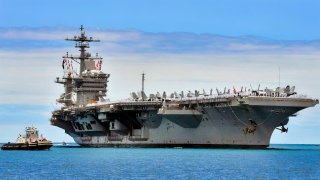The U.S. Navy Sees a Worrying Trend: China Is Building a Massive Aircraft Carrier Fleet
China is aggressively expanding its aircraft carrier fleet, reflecting a broader ambition to exert global influence, particularly in the Indo-Pacific region.
Summary: China is aggressively expanding its aircraft carrier fleet, reflecting a broader ambition to exert global influence, particularly in the Indo-Pacific region. This expansion, part of a massive shipbuilding effort, includes the commissioning of the Liaoning, the domestically-built Shandong, and the more advanced Fujian, with a fourth carrier, the Type 004, in development. While China's carriers, especially the older ones, do not match the capabilities of the US fleet, the introduction of modern carriers like the Fujian, possibly equipped with advanced technologies, marks a significant step. However, the US maintains a superior carrier fleet in both quality and quantity. More pressing for US strategists are China's other military advancements, such as attack submarines and hypersonic missiles, which could challenge US naval dominance in the Indo-Pacific.
China's Rising Seas: The Strategic Shift Behind Its Growing Aircraft Carrier Fleet
China is working doggedly to expand their aircraft carrier fleet, an effort consistent with their wider intention to assert global influence and establish hegemony in the Indo-Pacific. What does Chinese carrier expansion mean for the United States?
China's Aircraft Carriers: Three and Counting...
The effort, now culminating in the world’s second-largest carrier fleet, began decades ago, when the Chinese purchased Soviet and Australian carriers for study in the 1980s. The study of the Soviet carrier Varyag led to the conversion and commissioning of the Liaoning in 2016. Then, China built their own aircraft carrier domestically, the Shandong, in 2019. Now, China is on the verge of delivering their third aircraft carrier, the advanced Fujian, with reports that a fourth, the Type 004, is already underway.
The point is that China is well underway towards generating a sizeable aircraft carrier fleet – which is all part of China’s ongoing shipbuilding spree, one of world history’s most ambitious. Undoubtedly, building an aircraft carrier fleet confers a level of prestige, and gives adversary reason for pause. Yet, questions persist over the quality – and survivability – of China’s aircraft carrier fleet.
Is China’s investment worthwhile? And should the US be worried?
China’s first carrier, the converted Varyag, is not especially impressive. China’s first domestically built carrier, the Shandong, represented a marked improvement over the converted carrier, yet still featured conventional power and a ski jump rather than nuclear power and a catapult. The improvement here was incremental, and still failed to put the carrier on par with anything in the American fleet.
The Fujian, however, is understood to be more modern and sophisticated, with a displacement of 80,000 tons and an electromagnetic catapult. The Type 004, meanwhile, is being constructed in secret; little is known about the Type 004, although, she is expected to feature nuclear propulsion and may feature weapons like lasers and railguns.
China’s slow-to-culminate effort, to build a viable carrier fleet, is part of a broader effort to expand its influence around the globe. But China’s conventionally powered carrier fleet will have geographic limitations, which should be okay for now, given that China’s most immediate concerns are nearby in the Indo-Pacific.
How Much of a Threat are the Aircraft Carriers from China?
The truth is, China, despite being a rising power, is a long way from being able to park an aircraft carrier in the Pacific, Atlantic, and Mediterranean simultaneously – in the way that the US has been doing for decades. The US is still decades ahead of China with respect to quality and quantity of aircraft carrier fleet.
And while a carrier fleet will enhance China’s ability to project airpower throughout the Indo-Pacific and to enforce territorial claims with more agility and precision, the US is still capable of delivering immense air power to the region.
More concerning to American war planners, perhaps, than China’s carriers, is China’s swift-moving surface vessels, attack submarines, intermediate-, and hypersonic missiles. Finding and destroying an aircraft carrier in the vastness of the ocean is no easy task, especially when the carrier is nuclear-powered and can stay on the move indefinitely.
But China is building a stockpile of tools that will help to contest the seas of the Indo-Pacific, upping the stakes for American intervention, or presence, in the region.
About the Author: Harrison Kass
Harrison Kass is a defense and national security writer with over 1,000 total pieces on issues involving global affairs. An attorney, pilot, guitarist, and minor pro hockey player, Harrison joined the US Air Force as a Pilot Trainee but was medically discharged. Harrison holds a BA from Lake Forest College, a JD from the University of Oregon, and an MA from New York University. Harrison listens to Dokken.


